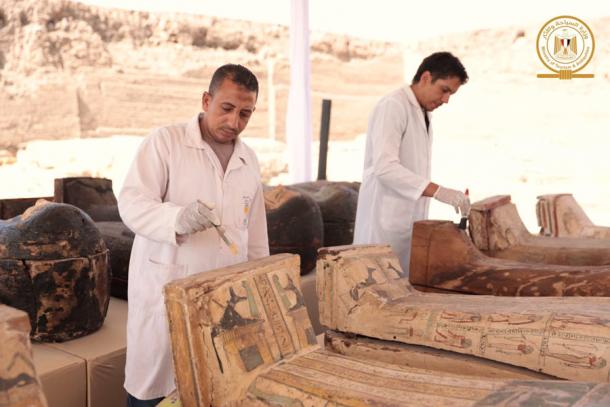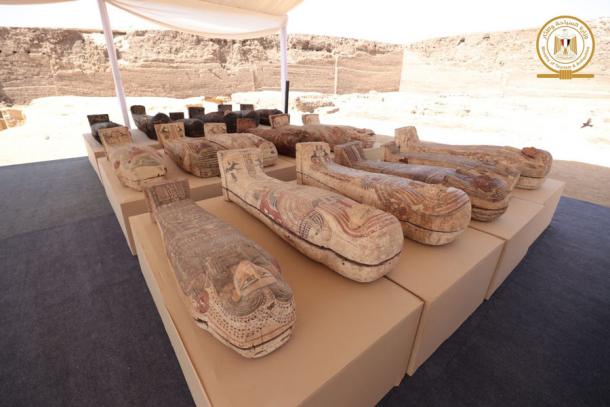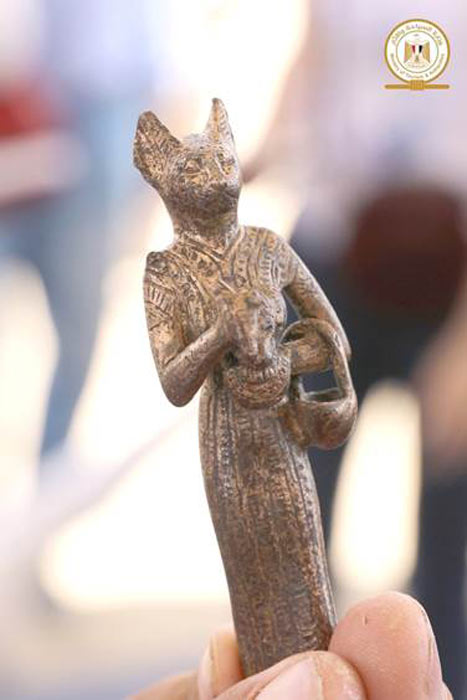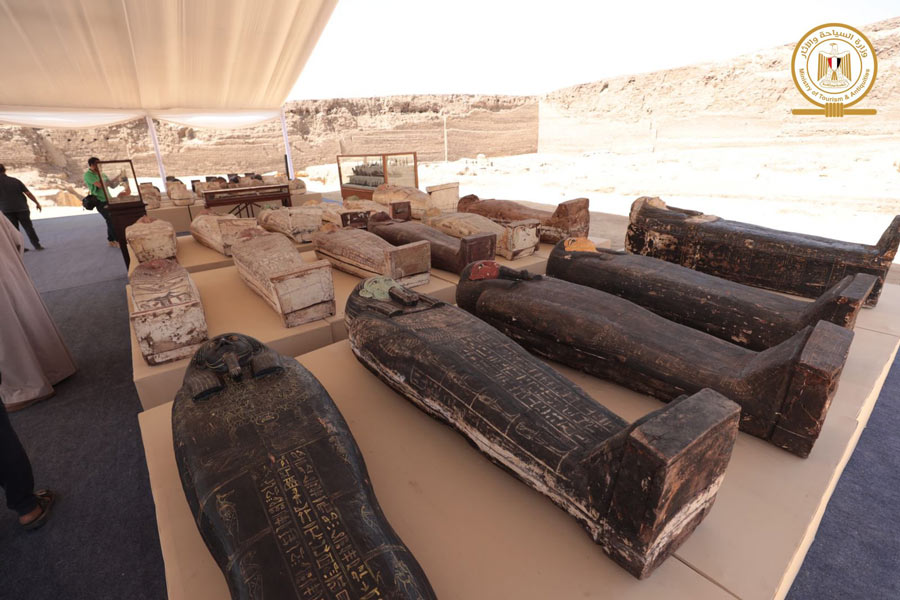New Treasures of Saqqara Showcased at the Pop-Up Djoser Exhibition
Egypt’s oldest pyramid in Saqqara was the spectacular venue for a pop-up Djoser exhibition in the desert outdoors. This is no tent with a few plastic chairs, but a fully equipped travelling museum with over 250 recently found ancient painted coffins on display and countless bronze artifacts.
On Monday, Egyptian heritage officials opened the makeshift Djoser exhibition featuring a collection of stunning ancient Egyptian artifacts. The temporary exhibition is located at the feet of the famous 2,500-year-old Step Pyramid of Djoser, at the necropolis of Saqqara, 24 kilometers (15 miles) southwest of Cairo.

Specialists working on preservation of the wooden sarcophagi. (Ministry of Tourism and Antiquities)
The Spectacular Djoser Exhibition Showcases Recent Treasures
Mostafa Waziri, head of the Egyptian Supreme Council of Antiquities told the Associated Press that the artifacts on display in the pop-up Djoser exhibition will ultimately be transferred to the new Grand Egyptian Museum, which is currently being built near the famed Giza Pyramid outside of Cairo.
- Mummies have had a bad wrap – it is time for a reassessment
- Impressive Tomb of Royal Scribe Unveiled at Saqqara Necropolis
The location of the pop-up Djoser exhibition, the Pyramid of Djoser, was built by Imhotep, an Egyptian chancellor and high priest during the reign of Pharaoh Djoser around 2630 BC. Measuring over 60 meters (200 feet) tall, with a base of 109 meters by 121 meters (358 feet by 397 feet), the Pyramid of Djoser was Egypt’s first successful attempt at building a stone pyramid. Today, it still represents one of the world's earliest monumental stone structures and it set the architectural standards for all future “true pyramids.”

A few of the 250 newly discovered mummy sarcophagi at the outdoor pop-up Djoser exhibition in Saqqara south of Cairo. (Ministry of Tourism and Antiquities)
250 Stunning Painted Sarcophagi With Mummies Inside!
The pop-up exhibition includes “250 painted sarcophagi,” each one with a well-preserved mummy inside. In ancient Egypt it was believed that the safe passage of the soul depended on the physical body’s preservation. This meant soft tissues and organs were carefully preserved with an array of chemicals to slow down the decaying processes. Therefore, what’s really on display in Saqqara is a selection of elite ancient Egyptians, all of whom were wealthy enough to pay for the expensive mummification processes and rites.
The 250 painted sarcophagi on display feature “apparently” random symbols and motifs, however, not a single painted line is without its deep spiritual reasoning. Further aiding the soul’s safe transition artisans painted and inscribed coffins with magical hieroglyphs, like for example “eyes,” through which the deceased could see outside the coffin. Furthermore, the deceased's name and titles were written with a list of food offerings, and false doors let the ka (soul) transition from this world to the next.
Bronze Treasure Too: Deities and Bronze Isis Ritual Vessels
The exhibition at Saqqara also features “150 bronze statues” of ancient deities and a collection of bronze vessels used in Isis rituals. According to a National Geographic article, in Greece, Isis originally corresponded with Demeter, the goddess of agriculture, and this is why she became the goddess of fertility in ancient Egyptian mythology. As Ptolemaic influence spread throughout the eastern Mediterranean around 500 BC, worship of Isis also travelled along the trade routes to the coastlines of modern-day Syria, Israel, and Turkey.
Perhaps one of the most significant pieces in the exhibition is a headless bronze statue of Imhotep. As the chancellor and chief architect of Pharaoh Djoser, who ruled between 2630 BC and 2611 BC, Imhotep was also a high priest of the sun god Ra at Heliopolis, and for these reasons he was glorified and deified after his death. According to the BBC, Imhotep's influence lived on well after his death and in the New Kingdom he was venerated as the “patron of scribes, personifying wisdom and education.”

The Djoser exhibition at Saqqara also featured “150 bronze statues” of ancient deities and a collection of bronze vessels used in Isis rituals. Cats feature prominently in ancient Egyptian art and gradually became divine protection symbols and elite funerary goods, like this bronze from the pop-up exhibition. (Ministry of Tourism and Antiquities)
Pop-up Exhibitions Past And Present
Unlike traditional museum exhibitions, pop-up exhibitions like the Djoser exhibition at Saqqara encourage visitors to interact with the pieces on display, and to open up conversations and discussions. The term “pop-up exhibition” describes any informal or temporary art or cultural event. After a swathe of pop-up restaurants appeared at the turn of the millennium the idea for the “pop-up exhibition” first appeared in New York City in 2007.
- Egyptian Elite Sarcophagi and Unique Gold Treasures Unearthed
- Cambodia Demands British Museums Return Stolen Khmer Artifacts
This pop-up exhibition at Saqqara is a first for the Pyramid of Djoser, but beginning back in 2016 fArt D’Egypte, a team of nine Egyptian women led by Nadine Abdel Ghaffar, staged annual pop-up exhibitions at other Egyptian heritage sites. In 2017, they opened at the Egyptian Museum, at the Manial Palace (2018), and in 2019 they exhibited at al-Mu’izz Street, before the pandemic closed them down.
Top image: Some of the 250 newly discovered mummy sarcophagi at the outdoor pop-up Djoser exhibition in Saqqara south of Cairo. Source: Egyptian Ministry of Antiquities
By Ashley Cowie



















